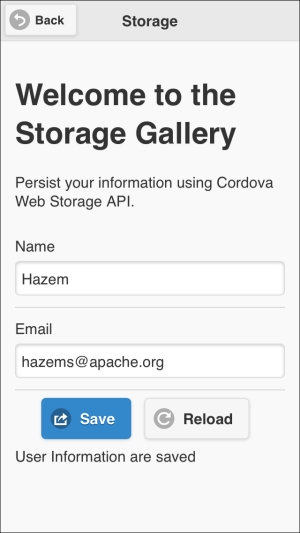The Cordova Storage API provides the ability to access the device storage options based on three popular W3C specifications:
- Web Storage API Specification, which allows you to access data using simple key/value pairs (which we will demonstrate in our
"Storage"demo). - Web SQL Database Specification, which offers full-featured database tables, which can be accessed using SQL. Note that this option is only available in Android, iOS, BlackBerry 10, and Tizen and not supported on other platforms.
- IndexedDB Specification is an API for the client-side storage and high performance. It searches on the stored data using indexes. Note that this option is available in Windows Phone 8 and BlackBerry 10.
In order to use the Storage API, there is no need for a CLI command to run, as it is built in Cordova. In order to access the Storage demo, you can do it by clicking on the Storage list item. You will be introduced to the Storage page. On the Storage page, the users can enter their names and valid e-mails and then click on the Save button in order to save the information, as shown in the following screenshot:

Saving user information
You can exit the app and then open the Storage page again; you will find that your saved information is reflected in the Name and Email fields. At any point, you can click on the Reload button in order to reload input fields with your saved data.
The following code snippet shows the "storage" page:
<div data-role="page" id="storage">
<div data-role="header">
<h1>Storage</h1>
<a href="#" data-role="button" data-rel="back" data-icon="back">Back</a>
</div>
<div data-role="content">
<h1>Welcome to the Storage Gallery</h1>
<p>Persist your information using Cordova Web Storage API.</p>
<form id="storageForm">
<div class="ui-field-contain">
<label for="userName">Name</label>
<input type="text" id="userName" name="userName"></input>
</div>
<div class="ui-field-contain">
<label for="userEmail">Email</label>
<input type="text" id="userEmail" name="userEmail"></input>
</div>
<div class="center-wrapper">
<input type="button" id="saveInfo" data-icon="action" value="Save" data-inline="true"/>
<input type="button" id="reloadInfo" data-icon="refresh" value="Reload" data-inline="true"/>
</div>
<ul id="storageMessageBox"></ul>
<div id="storageResult">
</div>
</form>
</div>
</div>The preceding "storage" page contains the following:
- A page header that includes a back button
- Page content that includes the
"storageForm"form, which includes the following elements:- "
userName": This is the user's name text field "userEmail": This is the user's email text field"saveInfo": This button is used to persist user information"reloadInfo": This button is used to reload saved user information in the"userName"and"userEmail"fields"messageBox": This is an unordered list that displays form validation errors"storageResult": This is a div that displays the storage operation result
- "
The following code snippet shows the "storage" page view controller JavaScript object that includes the event handlers of the page (storage.js):
(function() {
var storageManager = StorageManager.getInstance();
var INFO_KEY = "cordovaExhibition.userInfo";
$(document).on("pageinit", "#storage", function(e) {
e.preventDefault();
$("#saveInfo").on("tap", function(e) {
e.preventDefault();
if (! $("#storageForm").valid()) {
return;
}
storageManager.set(INFO_KEY, JSON.stringify({
userName: $("#userName").val(),
userEmail: $("#userEmail").val()
})
);
$("#storageResult").html("User Information are saved");
});
$("#reloadInfo").on("tap", function(e) {
e.preventDefault();
reloadUserInfo();
$("#storageResult").html("Reloading completes");
});
});
$(document).on("pageshow", "#storage", function(e) {
e.preventDefault();
$("#storageForm").validate({
errorLabelContainer: "#storageMessageBox",
wrapper: "li",
rules: {
userName: "required",
userEmail: {
required: true,
email: true
}
},
messages: {
userName: "Please specify user name",
userEmail: {
required: "Please specify email",
email: "Please enter valid email"
}
}
});
reloadUserInfo();
});
function reloadUserInfo() {
var userInfo = JSON.parse(storageManager.get(INFO_KEY));
populateFormFields(userInfo);
}
function populateFormFields(userInfo) {
if (userInfo) {
$("#userName").val(userInfo.userName);
$("#userEmail").val(userInfo.userEmail);
}
}
})();As shown in the preceding highlighted code snippet, the "pageinit" event handler registers the "tap" event handlers on the "saveInfo" and "reloadInfo" buttons.
Tip
In order to validate our "storage" form, we use the jQuery validation plugin, which can be found at http://jqueryvalidation.org. In order to use the plugin, all we need to do is include the jquery.validate.min.js file below the jquery.js file that will be shown in the index.html file in Finalizing the Cordova Exhibition App section. After including the jQuery validation plugin JS file, we can simply use the plugin by defining the validation rules on the form fields using the form's validate() method and then validate the form using the form's valid() method, as shown in the "storage" page view controller code.
In the "tap" event handler of the "saveInfo" button:
- The
"storageForm"is validated using the$("#storageForm").valid()method. - If the form is valid, then both the
"userName"and"userEmail"valid input text values are set as attributes in a JSON object, which is converted to a string usingJSON.stringify(). Finally, thestringifiedJSON object is persisted in the device storage by calling thestorageManager.set(key, value)specifying key to beINFO_KEYand the value to be thestringifiedJSON object.
In the "tap" event handler of the "reloadInfo" button:
- The user information is retrieved by calling
reloadUserInfo(). ThereloadUserInfo()method callsstorageManager.get(INFO_KEY)in order to get the storedstringifiedJSON object and then useJSON.parse()in order to convert thestringifiedJSON object to a JSON object (userInfo). - Using
populateFormFields(userInfo),userInfois populated to both"userName"and"userEmail"input text elements.
In the "pageshow" event of the "storage" page, our "storageForm" form validation is constructed by specifying the options parameter of the form's validate() method as follows:
errorLabelContainer: This is set to"storageMessageBox"to display the validation errorswrapper: This is set to"li"to wrap the error messages in list itemsrulesobject is set as follows:userName: This is set to requireduserEmail: This is set to be an e-mail and required
messagesobject specifiesuserNameanduserEmailvalidation error messages
Finally, in the "pageshow" event of the "storage" page, reloadUserInfo() is called to reload the user information in the "userName" and "userEmail" input text elements.
The following code snippet shows StorageManager.js that does a simple wrapping for two localStorage methods:
var StorageManager = (function () {
var instance;
function createObject() {
return {
set: function (key, value) {
window.localStorage.setItem(key, value);
},
get: function (key) {
return window.localStorage.getItem(key);
}
};
};
return {
getInstance: function () {
if (!instance) {
instance = createObject();
}
return instance;
}
};
})();As you can see in the preceding highlighted code, StorageManager is a singleton object that has the following methods:
Tip
The complete W3C Web Storage specification is available at http://www.w3.org/TR/webstorage/, and you can also look at the W3C Web SQL Database specification at http://dev.w3.org/html5/webdatabase/. Finally, you can look at the W3C IndexedDB specification at http://www.w3.org/TR/IndexedDB/.
Now, we are done with the storage functionality in the Cordova Exhibition app.
